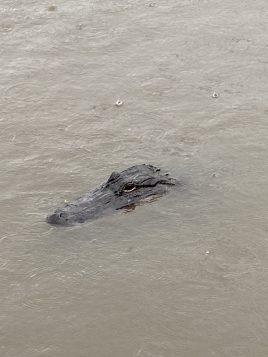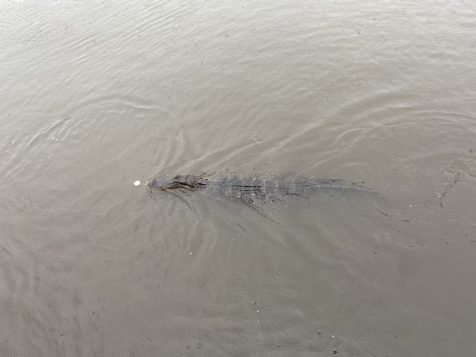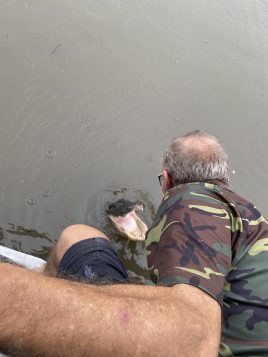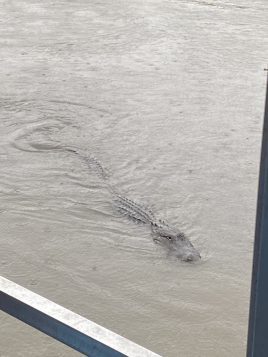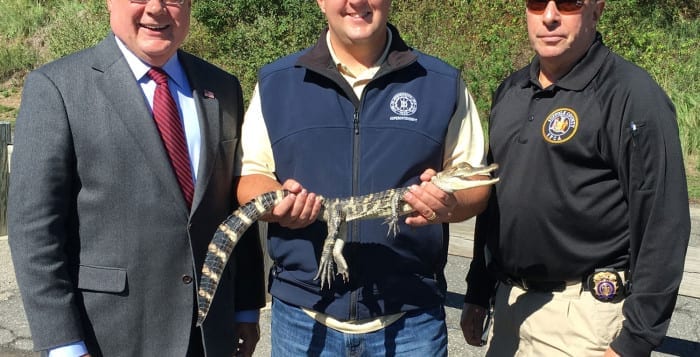By Daniel Dunaief

The drive to the Louisiana swamps took over half an hour and was a world away from the incredible jazz, po’ boys and other sites, sounds and tastes of New Orleans.
Once we left the highway, the road curled so dramatically that 15-mile-per-hour speed limit signs seemed unnecessary.
Homes along the way provided a snapshot into the sobering reality of the lives of people who live along the path. The roof of a dilapidated front porch looked like a crushed soda can, blocking the entrance to a house. Across from another home, a white hearse with a rusted roof was parked feet from the intracoastal canal. In a steady drizzle, the driver’s side window remained open.
Once we parked at the Louisiana Tour company’s parking lot, we waited on a small dock, watching a tug boat push an enormous ship about 50 feet from us through floating plants.
Our tour guide and driver Reggie Domangue provided a compelling commentary.
Passing a cemetery along the water’s edge, Reggie described how flood waters pushed a friend’s grandmother above ground twice, forcing his friend to bury his grandmother three times.
Downstream from the cemetery, a fishing boat called Perfect Coup rested on its side, its decaying carcass a testament to the destructive force of an earlier hurricane.
Reggie didn’t let several missing teeth slow him down. Sharing a narrative that mirrored the winding path through the water, he offered a few verbal gems. When talking about edible parts of the alligator, he suggested, “You fry it, we’ll eat it.”
Warning passengers about the dangers in the water, Reggie cautioned some clothing was more problematic than others. “You go swimmin’ out here, you don’t want to wear no white.” Moving slowly along the canal, he pointed out the ubiquitous Spanish moss. Years ago, Reggie said, people stuffed it in their pillows until they realized the dried-out moss was flammable.
Heading toward a highlight of the trip, Reggie described the territorial alligators. Noticeable from the ripples atop the water and its v-shaped wake, a 10-foot alligator approached, as Reggie yelled in French, “ici,” for “here.”
Reggie tossed marshmallows to the alligators. He hand-fed one of the alligators, whose mouth closed so rapidly its teeth snapped. As we coasted slowly through the bayou, alligators swam up to the boat. Two raced toward the same marshmallow. After colliding, the only thing left temporarily unscathed was the floating marshmallow.
Reggie said alligators swim on top of the water at 10 miles per hour and below the water at 15. On land, they can move as quickly as 25, although they can’t make quick turns.
Alligators eat small animals and birds. If they catch deer, they can’t eat them because the meat is too tough. Instead, they trap them under a branch, marinating them for two weeks.
The gender of newborn alligators depends on the temperature of the water. Below 86 degrees, the alligators are female. Above that, they’re male.
Female alligators maintain a territory of half a mile, while males have one-mile territories. A male in search of a mate can travel 10 miles a day.
Louisiana has strict poaching rules. Anyone caught poaching an alligator can receive a mandatory 10 years in prison. “People have done less time for murder,” Reggie said.
If you think Reggie sounds like he’s straight out of central casting, you’re not alone. The writers of Disney’s “Princess and the Frog” movie agreed. According to Reggie, Disney executives came on one of his boat rides and modeled the character Raymond, the firefly who’s also missing teeth, after Reggie.
Disney thanked Reggie in the credits. His passengers, including my wife and me, felt the same way after a memorable journey.

